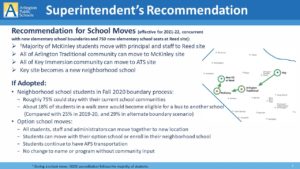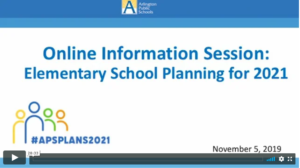School Board Adopts Superintendent’s Recommendation to Move Schools – Feb.7, 2020
Challenges | Goals | Proposals | Comparative Analysis & Suggested Community Proposals |Engagement (Community Meetings) | FAQs | Preguntas Frecuentes es español | Letters from PTAs | Resources | Questionnaire Responses
Jan. 24, 2020 Webinar on Staff Analysis, including Proposals from Community
Superintendent’s Recommendation for School Moves
Jan. 9, 2020 School Board Information Session: Presentation
Jan. 9, 2020 Meeting Livestream: https://aps2016.apsva.us/engage/livestream/
Dec. 9 Community Meeting Presentation: apsva.us/wp-content/uploads/2019/12/Dec.-9-Community-Mtg-on-ES-Planning-Slides.pdf
Dec. 9 Community Meeting Livestream (12/9): https://aps2016.apsva.us/engage/livestream/
Infographic about the Elementary School Planning Process
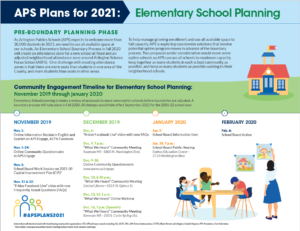 En español
En español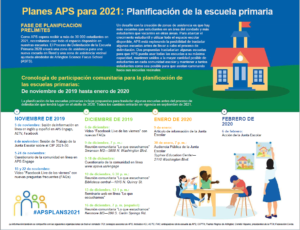
Online Information Session, Nov. 5, 2019
Sesión Informativa en lÍnea – el 5 de noviembre, 2019
Overview
As Arlington Public Schools (APS) expects to welcome more than 30,000 students in 2021, we need to use all available space at our schools. An Elementary School Boundary Process in fall 2020 will create an attendance zone for a new school at Reed and an adjusted neighborhood attendance zone around Arlington Science Focus School (ASFS). One challenge with creating attendance zones is that there are more seats than students in one area of the County, and more students than seats in other areas.To help manage growing enrollment and use all available space to full capacity, APS is exploring countywide solutions that involve potential option program moves in advance of the boundary process. Two proposals under consideration would move someoption schools so APS can use all schools to maximum capacity, keep together as many students in each school community as possible, and keep as many students as possible walking to ES in their neighborhood schools.
The Challenges APS Faces in the 2020 Elementary School Boundary Process
The first phase of the boundary process is a planning process to address the challenge of using all elementary schools to full capacity given the imbalance between where elementary school students live and the available neighborhood seats across the county. APS seeks to do this in a way that makes efficient use of resources and keeps the majority of students in each school community together.
- Enrollment projections for 2023-24 show rapid growth of elementary school students concentrated along the major transportation corridors, including Rosslyn-Ballston, Columbia Pike and
 Route 1, where APS does not have enough neighborhood school seats.
Route 1, where APS does not have enough neighborhood school seats. - The opening of the new elementary school at Reed will create a surplus of neighborhood elementary school seats in one part of the county (see map 2: Gap Between Projected Elementary Students and Future Seats in SY 2023-24).
- The map uses 2023-24 enrollment projections to show where the numbers of elementary school students is expected to grow in comparison to where APS has neighborhood seats.
- Zone 1 is projected to have more permanent seats than students (+116 seats) due to the additional 725 seats available with the opening of Reed in 2021.
- Zones 2 through 4 are projected to have a combined need for 906 seats (Fall 2023-24).
- Among these zones, the greatest need for seats (-399) are slated for the six schools in the vicinity of the Rosslyn-Ballston corridor (Zone 2), followed by nine schools in the vicinity of the Columbia Pike corridor (Zone 3), and the two schools in the U.S. 1 corridor (Zone 4).
- Revisions to the Options & Transfers policy in 2017 changed the designation of a neighborhood/option school in the Rosslyn-Ballston corridor (Immersion) to an option school (without the neighborhood guarantee).
What-If: Potential Impacts on the Upcoming Boundary Process
This Representative Boundary Scenario map (formerly the What-If Scenario for Planning for the 2020 Elementary Boundary Process) is a visual representation of a “what 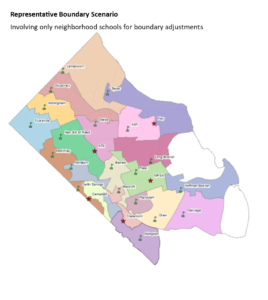 if” scenario that shows what boundaries could potentially look like in September 2021, given the challenges APS faces today. This map demonstrates, for discussion purposes, the long, extended boundaries that would be required if APS uses existing schools efficiently (to maximum capacity).
if” scenario that shows what boundaries could potentially look like in September 2021, given the challenges APS faces today. This map demonstrates, for discussion purposes, the long, extended boundaries that would be required if APS uses existing schools efficiently (to maximum capacity).
For example, under this scenario:
- Approximately 4,000+ or 38% of all neighborhood elementary students would be reassigned to a new school;
- Nearly half of neighborhood schools would lose some of their walkable planning units;
- Almost 700 students who currently could walk to their neighborhood schools would be eligible for bus transportation, adding approximately 12 buses to our fleet of almost 200 buses.
- No option schools would move
Observations:
- Almost every boundary is changed except for Drew, Hoffman-Boston, Oakridge, Randolph
- ASFS is located within its boundary
- Ashlawn and McKinley have long & extended boundaries
- Ashlawn’s boundary is split into two separate sections
- Carlin Springs is located outside of its boundary
Goals for Elementary Planning and Preparing for 30,000 Students
- Keep as many students together in each school community as possible;
- Enable walking to neighborhood schools as much as possible;
- Use all existing elementary schools to full capacity;
- Meet needs for seats in high-growth areas;
- Develop a plan that best utilizes existing school facilities located on available land in the county but not always matching where neighborhood seats are needed for current and projected growth; and
- Consider options that will best address recent student enrollment projections, which indicate that up to three new elementary schools may be needed in the next 10 years.
What Can We Do Differently?
Two draft proposals explore moving some countywide option schools for 2021-22 school year. Decisions will establish framework and foundation for the Fall 2020 Elementary Boundary Process.
School Moves Proposal 1:
- Majority of McKinley students moves to Reed
- Arlington Traditional moves to McKinley building
- Key Immersion moves to Arlington Traditional building
- Key building becomes a neighborhood school
This proposal would:
- keep more McKinley students together (40% of McKinley students live in Reed walk zone);
- allows about 100 more students, including siblings, to enroll in ATS from its waitlist;
- places Immersion in a central location;
- creates neighborhood seats in high-growth Rosslyn area; and
- allows future capital efforts to focus on Columbia Pike area.
If this proposal is adopted, then the following is expected in the 2020 boundary process:
- More than 2,400 or about 23% of all neighborhood elementary school students would be reassigned to another school
- About 18% of elementary neighborhood school students who live in a walk zone would become eligible for a bus
- Two countywide option schools would be moved
School Moves Proposal 2 – Update: Please note that staff has determined that it will not advance this proposal for recommendation to the School Board.
- Majority of McKinley students move to Reed
- Arlington Traditional moves to McKinley building
- Campbell Expeditionary Learning moves to the Arlington Traditional building
- Key Immersion moves to Carlin Springs building
- Majority of Carlin Springs students move to Campbell
- Campbell building becomes a neighborhood school
- Key building becomes a neighborhood school
This proposal would:
- Keep more McKinley students together (40% of McKinley students live in Reed walk zone);
- Allows about 100 more students, including siblings, to enroll in ATS from its waitlist;
- Moves Campbell Expeditionary Learning to a central location;
- Moves Immersion to an area with a high number of Spanish speakers;
- Moves the majority of Carlin Springs students to a walkable neighborhood school at Campbell;
- Creates neighborhood seats in high-growth Rosslyn area; and
- Allows future capital efforts to focus on Columbia Pike area
If this proposal is adopted, then the following is expected in the 2020 boundary process:
- More than 2,100 or about 20% of all neighborhood elementary school students would be reassigned to another school
- About 13% of elementary neighborhood school students who live in a walk zone would become eligible for a bus
- Three countywide option schools would be moved
Community Engagement – November 2019 Through January 2020
- The proposals under consideration may be revised after APS gathers input from stakeholders, and any new proposals will be shared with the community.
- Continuous updates to Engage page, including regular additions to FAQs and community input posts
- Weekly updates to APS School Ambassadors
- Social media posts with graphics, link to Engage page and video, featuring engagement dates
- School Talk messages
- Text messages for important, time-sensitive alerts
- Video on APS Engage and AETV, social media (English with Spanish subtitles)
- Visit aps2016.apsva.us/engage to view the proposals, timeline, infographic, maps, handouts and other background information.
Community Engagement Activities
| DATE | ACTIVITY |
| Oct. 30 | Fall Meeting with APS Ambassadors and PTA Presidents |
| Nov. 5 | Online Information Sessions (English/Spanish) available via APS Engage, AETV, Facebook |
| Nov. 6 | CIP Work Session, 7-9 p.m. (Syphax Education Center, 2110 Washington Blvd) |
| Nov. 15, 22 | “Friday Facebook Live” video with new FAQs |
| Dec. 2 | Elementary School Planning Q&A Session with Elementary PTA Presidents |
| Dec. 6 | “Friday Facebook Live” video with new FAQs |
| Dec. 9 | Community Meeting (Swanson, 7 p.m.—LIVE BROADCAST) |
| Dec. 10 | Community Meeting (Central Library, 6:30 p.m.) |
| Dec. 13 | Online Webinar (12-1 p.m.) |
| Dec. 16 | Spanish Community Meeting (Kenmore, 7 p.m.) |
School Board Action Timeline
- Jan. 9, 2020: Staff will present final revised scenarios to the School Board for Information
- Jan. 30, 2020: School Board Public Hearing on the final proposal(s)
- Feb. 6, 2020: School Board is scheduled to take action on final proposal(s)
Frequently Asked Questions (Updated Nov. 13)
Frequently Asked Questions (English)
Preguntas Frecuentes (FAQs, por sus siglas en inglés)
Resources
Summer 2019 ES Planning Materials NEW
Analysis of Students Moving provides examples of how neighborhood school enrollment and the number of students in walk zones (highlighted in yellow in each table) could be impacted in each of the school moves proposals. (Revised Nov. 16, 2019)
Analysis of Walkers and Bus Eligible Students by Proposals (formerly the Analysis of Walk Zones, revised Nov. 27, 2019). Provides information on panning units and walk zones including, number of potential walkers in the county; the walker/bus eligible totals for the Representative Scenario and each School Move Proposal; and a list of all planning units, indicating which are in a school walk zone by proposal.
Pre-K & Elementary Options & Transfers Application Data School Year 2019-20
Arlington Facilities and Student Accommodation Plan (AFSAP)
School Capacity (p.25) and Inventory of Relocatable Classrooms (p.56) in the 2019 AFSAP
Elementary School Expanded Walk Zones
Transportation 101: Video Presentation on transportation system overview, ridership statistics and ongoing challenges (presentation in PDF)
 Contact
Contact  Calendars
Calendars Careers
Careers Engage
Engage  District
District
